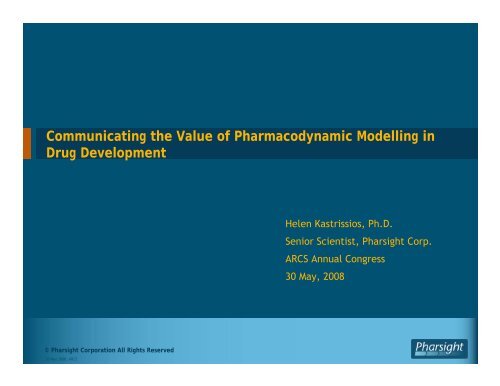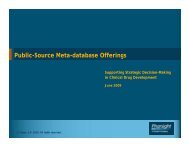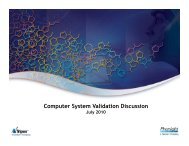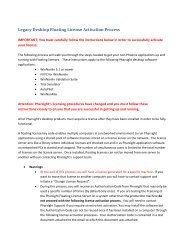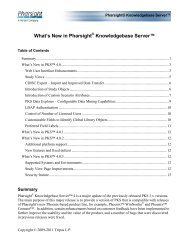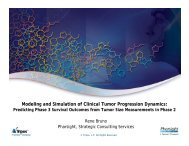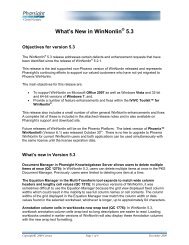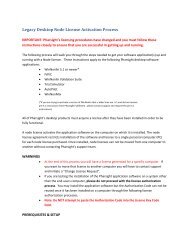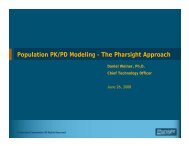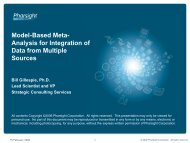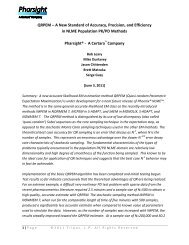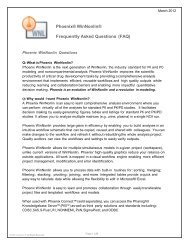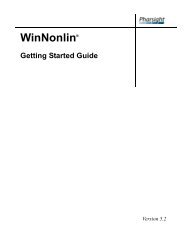Communicating the Value of Pharmacodynamic Modelling in Drug ...
Communicating the Value of Pharmacodynamic Modelling in Drug ...
Communicating the Value of Pharmacodynamic Modelling in Drug ...
You also want an ePaper? Increase the reach of your titles
YUMPU automatically turns print PDFs into web optimized ePapers that Google loves.
<strong>Communicat<strong>in</strong>g</strong> <strong>the</strong> <strong>Value</strong> <strong>of</strong> <strong>Pharmacodynamic</strong> <strong>Modell<strong>in</strong>g</strong> <strong>in</strong><br />
<strong>Drug</strong> Development<br />
Helen Kastrissios, Ph.D.<br />
Senior Scientist, Pharsight Corp.<br />
ARCS Annual Congress<br />
30 May, 2008<br />
© Pharsight Corporation All Rights Reserved<br />
30 May 2008, ARCS
Traditionally, drug development is a lengthy and<br />
costly process.<br />
Significant <strong>in</strong>crease <strong>in</strong><br />
<strong>in</strong>vestment and productivity<br />
Productivity is decl<strong>in</strong><strong>in</strong>g<br />
A key problem is separat<strong>in</strong>g <strong>the</strong> w<strong>in</strong>ners from <strong>the</strong> losers early.<br />
slide 2<br />
30 May 2008, ARCS<br />
© Pharsight Corporation All Rights Reserved
FDA Perspective<br />
There is a clear emerg<strong>in</strong>g message from <strong>the</strong> FDA regard<strong>in</strong>g <strong>the</strong>ir view <strong>of</strong> <strong>the</strong><br />
importance <strong>of</strong> <strong>Modell<strong>in</strong>g</strong> and Simulation (M&S) to reduce <strong>the</strong> cost, time, and<br />
uncerta<strong>in</strong>ty <strong>in</strong> gett<strong>in</strong>g new medical products to patients.<br />
Critical Path White Paper (March, 2004) and Report (March, 2006)*<br />
● Proposes utilization <strong>of</strong> model-based approaches to improve knowledge<br />
management and decision-mak<strong>in</strong>g<br />
Guidances<br />
● In 1999, FDA issued “Guidance for Industry | Population Pharmacok<strong>in</strong>etics”<br />
● In 2003, FDA issued “Guidance for Industry | Exposure-response<br />
relationships: Study Design, Data Analysis, and Regulatory Applications”<br />
New focus on End-<strong>of</strong>-Phase IIa meet<strong>in</strong>gs<br />
*http://www.fda.gov/oc/<strong>in</strong>itiatives/criticalpath/<br />
● Goal: Reduce unnecessary late stage (IIb, III) failures by<br />
• Review <strong>of</strong> dose vs. response models , exposure vs. response<br />
models, drug – disease models, simulations <strong>of</strong> phase IIb and<br />
preparation for phase III trial design<br />
• Review dose adjustment strategies for special populations<br />
• Review cl<strong>in</strong> pharm and biopharmaceutical issues, as well as<br />
newer areas <strong>of</strong> uncerta<strong>in</strong>ty: QT trial design, pharmacogenomic<br />
and paediatric considerations<br />
slide 3<br />
30 May 2008, ARCS<br />
© Pharsight Corporation All Rights Reserved
Reasons for <strong>in</strong>efficiencies <strong>in</strong> cl<strong>in</strong>ical<br />
development …<br />
Inefficient decision mak<strong>in</strong>g processes (poor knowledge<br />
management)<br />
● lack <strong>of</strong> necessary <strong>in</strong>formation to make <strong>in</strong>formed decisions<br />
● decisions not based on quantitative <strong>in</strong>puts<br />
● focus on <strong>the</strong> wrong areas (e.g., speed to market as opposed to<br />
understand<strong>in</strong>g <strong>the</strong> dose response)<br />
● loss <strong>of</strong> knowledge due to changes <strong>in</strong> staff and assignments<br />
● <strong>in</strong>ability to capture <strong>in</strong>formation (such as how and why decisions<br />
were made, <strong>in</strong>tellectual property, etc.)<br />
Lack <strong>of</strong> (efficient) utilization <strong>of</strong> technology<br />
slide 4<br />
30 May 2008, ARCS<br />
© Pharsight Corporation All Rights Reserved
…. And What Can Be Done About It?<br />
Model-Based <strong>Drug</strong> Development (MBDD)<br />
● Ra<strong>the</strong>r than fill<strong>in</strong>g <strong>in</strong> gaps <strong>in</strong> knowledge, M&S is now<br />
be<strong>in</strong>g used to better design future studies and drug<br />
development programs:<br />
• Optimize cl<strong>in</strong>ical drug development focus on<br />
establish<strong>in</strong>g exposure-response relationships to allow<br />
correct choice <strong>of</strong> dose(s)<br />
• Establish <strong>the</strong> use <strong>of</strong> drug-disease models and<br />
advanced pharmacometric concepts <strong>in</strong> early drug<br />
development<br />
• Promote <strong>the</strong> use <strong>of</strong> <strong>in</strong>novative cl<strong>in</strong>ical designs early <strong>in</strong><br />
cl<strong>in</strong>ical development to establish pro<strong>of</strong> <strong>of</strong> concept<br />
and exposure-response relationships<br />
slide 5<br />
30 May 2008, ARCS<br />
© Pharsight Corporation All Rights Reserved
Model-Based <strong>Drug</strong> Development<br />
Key Considerations<br />
Goal<br />
● Tools for computer assisted trial simulation<br />
● Data repositories<br />
● Standardization <strong>of</strong> tools, databases and practices<br />
● <strong>Communicat<strong>in</strong>g</strong> outcomes to decision-makers<br />
● SMALLER NUMBER OF FAILED TRIALS<br />
• Reduced cost associated with trials<br />
• Increased certa<strong>in</strong>ty <strong>in</strong> trial designs<br />
• Lower rate <strong>of</strong> late-stage attrition<br />
• Studies <strong>in</strong> appropriate populations<br />
slide 6<br />
30 May 2008, ARCS<br />
© Pharsight Corporation All Rights Reserved
Examples <strong>of</strong> Applications <strong>of</strong> MBDD<br />
Historically, typical PK/PD applications <strong>in</strong>clude:<br />
● What are <strong>the</strong> important determ<strong>in</strong>ants <strong>of</strong> drug exposure – age,<br />
weight, gender, ethnicity, renal function? Which is <strong>the</strong> most<br />
important?<br />
● What is <strong>the</strong> relationship between exposure and <strong>the</strong> <strong>in</strong>cidence<br />
<strong>of</strong> adverse events – eg nausea, fatigue, diarrhoea, major<br />
bleeds?<br />
● What is <strong>the</strong> relationship between exposure and cl<strong>in</strong>ical<br />
outcome – eg change <strong>in</strong> fast<strong>in</strong>g plasma glucose, LDL<br />
reduction, reduction <strong>in</strong> tumour size?<br />
slide 7<br />
30 May 2008, ARCS<br />
© Pharsight Corporation All Rights Reserved
Newer focus <strong>of</strong> MBDD<br />
PK/PD applications <strong>in</strong> MBDD <strong>in</strong>clude:<br />
● Pre-cl<strong>in</strong>ical (In-vitro → <strong>in</strong>-vivo)<br />
• What is <strong>the</strong> effect <strong>of</strong> disease progression on<br />
PK/PD?<br />
• Selection <strong>of</strong> dose ranges for first <strong>in</strong> man (FIM)<br />
studies<br />
● Early Development<br />
• Identify doses and dose escalation steps →<br />
evaluate different study designs<br />
• Identify useful metrics <strong>of</strong> exposure and identify<br />
relationships with safety and efficacy<br />
slide 8<br />
30 May 2008, ARCS<br />
© Pharsight Corporation All Rights Reserved
PK/PD applications <strong>in</strong> MBDD<br />
● Mid-late phase Development<br />
• What is <strong>the</strong> optimal number and tim<strong>in</strong>g <strong>of</strong> plasma<br />
samples to be drawn <strong>in</strong> a Phase 2a study to determ<strong>in</strong>e<br />
exposure-response?<br />
• Competitive position<strong>in</strong>g – what is <strong>the</strong> predicted fraction<br />
<strong>of</strong> patients and <strong>the</strong>ir characteristics who might achieve<br />
a response or develop adverse effects; who does it<br />
compare with competitors.<br />
• What dos<strong>in</strong>g regimens should be taken <strong>in</strong>to Phase 3?<br />
• What is <strong>the</strong> expected difference <strong>in</strong> response between<br />
naïve patients and patients non-naïve to ma<strong>in</strong>tenance<br />
treatment?<br />
• Evaluation <strong>of</strong> compet<strong>in</strong>g study designs – eg what is <strong>the</strong><br />
effect <strong>of</strong> a run-<strong>in</strong> period <strong>of</strong> vary<strong>in</strong>g lengths (0, 2 or 4<br />
weeks)?<br />
slide 9<br />
30 May 2008, ARCS<br />
© Pharsight Corporation All Rights Reserved
… and from a cl<strong>in</strong>ical perspective:<br />
What is <strong>the</strong> expected cl<strong>in</strong>ical response for a treatment <strong>in</strong> a<br />
particular patient population?<br />
What is <strong>the</strong> level <strong>of</strong> certa<strong>in</strong>ty surround<strong>in</strong>g predicted response?<br />
How do different treatment strategies and target patient subpopulations<br />
impact response?<br />
What is <strong>the</strong> probability that response is less or greater than a<br />
specific target?<br />
What dose is required to achieve a target response?<br />
What is <strong>the</strong> probability <strong>of</strong> achiev<strong>in</strong>g a specific efficacy target while<br />
keep<strong>in</strong>g probability for adverse events below a certa<strong>in</strong> level?<br />
How do <strong>the</strong> attributes for <strong>the</strong> compound compare to competitors?<br />
What is optimal position<strong>in</strong>g strategy versus competitors to balance<br />
safety and efficacy?<br />
slide 10<br />
30 May 2008, ARCS<br />
© Pharsight Corporation All Rights Reserved
To simulate drug development scenarios <strong>of</strong> <strong>in</strong>terest, a<br />
number <strong>of</strong> sub-models are developed and <strong>in</strong>tegrated<br />
Pharmaco<strong>the</strong>rapeutics<br />
<strong>Pharmacodynamic</strong>s<br />
Pharmacok<strong>in</strong>etics<br />
Dos<strong>in</strong>g<br />
Regimes<br />
Exposures<br />
Efficacy &<br />
tolerability<br />
endpo<strong>in</strong>ts<br />
Cl<strong>in</strong>ical<br />
Pr<strong>of</strong>ile<br />
Cl<strong>in</strong>ical<br />
Events<br />
1 or more drugs<br />
Information<br />
Sources<br />
• Precl<strong>in</strong>ical data<br />
• Early-phase trial results<br />
• Late phase results<br />
• In-house experts<br />
• Public <strong>in</strong>formation<br />
F<strong>in</strong>ancial<br />
<strong>Value</strong><br />
Market<br />
economics<br />
slide 11<br />
30 May 2008, ARCS<br />
© Pharsight Corporation All Rights Reserved
Public-Source Data<br />
Provides rich <strong>in</strong>formation to better understand product pr<strong>of</strong>iles,<br />
competitive position<strong>in</strong>g, variability and uncerta<strong>in</strong>ty <strong>in</strong> drug<br />
development.<br />
Public data sources <strong>in</strong>clude<br />
•journal articles<br />
• regulatory documents (e.g., FDA Summary Basis for<br />
Approval)<br />
• package <strong>in</strong>serts<br />
• published abstracts or poster presentations<br />
• meet<strong>in</strong>g proceed<strong>in</strong>gs<br />
• onl<strong>in</strong>e resources (e.g., press releases about new<br />
cl<strong>in</strong>ical trial results, onl<strong>in</strong>e cl<strong>in</strong>ical trial registries)<br />
slide 12<br />
30 May 2008, ARCS<br />
© Pharsight Corporation All Rights Reserved
Public-Source Data<br />
● Public-source data helps <strong>in</strong>form:<br />
• efficacy/safety pr<strong>of</strong>ile <strong>of</strong> established standards <strong>of</strong> care<br />
• <strong>the</strong> likely cl<strong>in</strong>ical pr<strong>of</strong>ile <strong>of</strong> an entity <strong>in</strong> <strong>the</strong> early stages <strong>of</strong><br />
cl<strong>in</strong>ical development<br />
• <strong>the</strong> natural progression <strong>of</strong> disease (model structures, parameter<br />
values, boundary conditions, placebo response)<br />
• effects <strong>of</strong> different treatment regimens, and potential<br />
covariates<br />
• comparative drug attributes (e.g.,relative potencies)<br />
• trends, relationships between endpo<strong>in</strong>ts, treatments<br />
• provides <strong>in</strong>itial estimates <strong>of</strong> variability and uncerta<strong>in</strong>ty<br />
• prediction <strong>of</strong> unobserved cl<strong>in</strong>ical outcomes: “borrow<strong>in</strong>g”<br />
<strong>in</strong>formation, such as response at time po<strong>in</strong>ts beyond those<br />
currently studied<br />
slide 13<br />
30 May 2008, ARCS<br />
© Pharsight Corporation All Rights Reserved
An example <strong>of</strong> an approach used to predict doseresponse<br />
for a new drug us<strong>in</strong>g public-source data<br />
= competitor and analogues<br />
= NCE<br />
Commercial<br />
Efficacy/<br />
Safety<br />
Cl<strong>in</strong>ical<br />
Utility<br />
Phase 2/3 public trials<br />
Biomarkers<br />
Efficacy/<br />
Safety<br />
Dose<br />
PK Biomarkers Efficacy/<br />
Safety<br />
Cl<strong>in</strong>ical<br />
Utility<br />
Phase I PKPD data<br />
slide 14<br />
30 May 2008, ARCS<br />
© Pharsight Corporation All Rights Reserved
Case Studies<br />
Example 1. How can precl<strong>in</strong>ical data be used to support<br />
dose selection for a FIM study?<br />
Example 2: How can M&S be used to support labell<strong>in</strong>g?<br />
Example 3: What is <strong>the</strong> product pr<strong>of</strong>ile <strong>of</strong> an NCE versus<br />
compet<strong>in</strong>g <strong>the</strong>rapies ?<br />
slide 15<br />
30 May 2008, ARCS<br />
© Pharsight Corporation All Rights Reserved
Example 1. How can precl<strong>in</strong>ical data be used to<br />
support dose selection for a FIM study?<br />
Allometric scal<strong>in</strong>g was used to predict human<br />
pharmacok<strong>in</strong>etics.<br />
Precl<strong>in</strong>ical PK/PD data from cynomolgous monkey, relative<br />
potency <strong>in</strong>formation and literature data was used for<br />
simulation.<br />
A range <strong>of</strong> doses (30-fold), regimens (QD and BID) and<br />
bioavailability fractions (5 to 50%) were used to project<br />
human PK vs. response pr<strong>of</strong>iles The comb<strong>in</strong>ation <strong>of</strong> dose and<br />
bioavailability ranges was chosen to compensate for any<br />
misspecification due to projection method or underly<strong>in</strong>g<br />
assumptions.<br />
Target <strong>the</strong>rapeutic range was determ<strong>in</strong>ed us<strong>in</strong>g publicly<br />
available literature for three comparators.<br />
slide 16<br />
30 May 2008, ARCS<br />
© Pharsight Corporation All Rights Reserved
Comparisons across regimens and drugs<br />
showed a favourable predicted response<br />
0 100 200 300<br />
%Time <strong>in</strong> Th. W<strong>in</strong>dow<br />
80<br />
60<br />
40<br />
20<br />
0<br />
Multiple BID<br />
Multiple QD<br />
0 100 200 300<br />
Dose (mg/day)<br />
slide 17<br />
30 May 2008, ARCS<br />
© Pharsight Corporation All Rights Reserved
The response was comparable to competitors<br />
Advserse Event Probability (%)<br />
100<br />
80<br />
60<br />
40<br />
20<br />
0<br />
QD regimen<br />
BID regimen<br />
<strong>Drug</strong> C<br />
Human projections for<br />
<strong>the</strong> NCE <strong>of</strong> <strong>in</strong>terest<br />
identified a dose<br />
which provided a<br />
similar safety pr<strong>of</strong>ile<br />
to that <strong>of</strong><br />
comparators.<br />
A1 A2 A3 A4 A5 A6 0 B1 B2 B3 N1 N2 N3<br />
<strong>Drug</strong> A Dose <strong>Drug</strong> B Dose NCE Dose<br />
(mg/day) (mg/day) (mg/day)<br />
slide 18<br />
30 May 2008, ARCS<br />
© Pharsight Corporation All Rights Reserved
Example 2: How can M&S be used to support<br />
labell<strong>in</strong>g?<br />
slide 19<br />
30 May 2008, ARCS<br />
© Pharsight Corporation All Rights Reserved
Docetaxel exposure-response model<strong>in</strong>g was<br />
performed <strong>in</strong> 640 patients<br />
Patients with solid tumor <strong>in</strong>clud<strong>in</strong>g metastatic breast and<br />
non-small cell lung cancer<br />
Docetaxel clearance and AUCs were estimated us<strong>in</strong>g<br />
population PK<br />
Likelihood <strong>of</strong> tumor response (CR and PR), time to<br />
progression, survival and toxicity (grade 4 neutropenia,<br />
febrile neutropenia…) were analyzed<br />
Source: R. Bruno et al. J. Cl<strong>in</strong>. Oncology 16, 187-196, 1998<br />
slide 20<br />
30 May 2008, ARCS<br />
© Pharsight Corporation All Rights Reserved
Docetaxel model<br />
Side effects<br />
Dose Exposure<br />
Biomarkers<br />
Tumor size<br />
dynamics<br />
Response<br />
rate Survival<br />
Progression<br />
Resistance<br />
slide 21<br />
30 May 2008, ARCS<br />
© Pharsight Corporation All Rights Reserved
Adverse events were related to docetaxel<br />
exposure<br />
Docetaxel AUC at first cycle was a significant<br />
<strong>in</strong>dependent predictor <strong>of</strong>:<br />
● grade 4 neutropenia (n = 582)<br />
● febrile neutropenia (n = 582)<br />
● fluid retention (n = 631)<br />
Source: R. Bruno et al. J. Cl<strong>in</strong>. Oncology 16, 187-196, 1998<br />
slide 22<br />
30 May 2008, ARCS<br />
© Pharsight Corporation All Rights Reserved
There was a cl<strong>in</strong>ically mean<strong>in</strong>gful <strong>in</strong>crease <strong>in</strong> <strong>the</strong> odds <strong>of</strong><br />
febrile neutropenia <strong>in</strong> patients with high exposure<br />
0.15<br />
Predicted Probability<br />
0.10<br />
0.05<br />
median AUC<br />
Generated <strong>the</strong> hypo<strong>the</strong>sis that<br />
patients with elevated LFTs<br />
might be at risk <strong>of</strong> <strong>in</strong>creased<br />
toxicity<br />
0.00<br />
2 4 6 8 10<br />
AUC (µg*h/mL)<br />
slide 23<br />
30 May 2008, ARCS<br />
© Pharsight Corporation All Rights Reserved
These results justified a safety analysis by liver enzymes<br />
that confirmed <strong>the</strong> risk <strong>in</strong> patient with elevated LFTs<br />
MBC patients treated at 100 mg/m 2 (Taxotere Package Insert)<br />
Side effects<br />
Febrile neutropenia<br />
Infection (grade 3-4)<br />
Stomatitis (grade 3-4)<br />
Toxic death<br />
Normal (n=730)<br />
2.4 %<br />
7.1 %<br />
7.8 %<br />
2.6 %<br />
Elevated (n=18)<br />
8.6 %<br />
33 %<br />
39 %<br />
17 %<br />
ODAC recommended approval <strong>in</strong> patients with normal LFTs without<br />
wait<strong>in</strong>g for Phase III results.<br />
Patients with elevated LFTs were excluded from Phase III studies.<br />
MBC = metastatic breast cancer; ODAC = Oncology <strong>Drug</strong>s Advisory Committee to US FDA<br />
slide 24<br />
30 May 2008, ARCS<br />
© Pharsight Corporation All Rights Reserved
Contribution <strong>of</strong> this approach to first approval <strong>in</strong><br />
metastatic breast cancer<br />
“Taxotere: … <strong>the</strong> value <strong>of</strong> nonl<strong>in</strong>ear mixed effects model<strong>in</strong>g <strong>of</strong><br />
dose–PK–PD relationships… was demonstrated… PK/PD analysis<br />
identified patients at risk for neutropenia, and justified <strong>the</strong><br />
subsequent safety re-analysis <strong>of</strong> <strong>the</strong> cl<strong>in</strong>ical database to address<br />
questions posed by… regulatory authorities, that allowed <strong>the</strong><br />
sponsor to confirm <strong>the</strong> pr<strong>of</strong>ile <strong>of</strong> <strong>the</strong> drug without wait<strong>in</strong>g for<br />
Phase 3 data… population PK/PD studies provided many<br />
advantages <strong>in</strong>clud<strong>in</strong>g:<br />
● A scientific and cl<strong>in</strong>ical basis by which safety concerns were<br />
alleviated…<br />
● Accelerated approval <strong>of</strong> <strong>the</strong> drug for market access.<br />
● Provision <strong>of</strong> key <strong>in</strong>formation <strong>in</strong> <strong>the</strong> package <strong>in</strong>sert.”<br />
Source: Lesko et al. Eur. J. Pharm. Sci. 10, iv-xiv, 2000<br />
slide 25<br />
30 May 2008, ARCS<br />
© Pharsight Corporation All Rights Reserved
Example 3: What is <strong>the</strong> product pr<strong>of</strong>ile <strong>of</strong> an NCE<br />
versus compet<strong>in</strong>g <strong>the</strong>rapies ?<br />
Gemcabene (CI-1027) is a non-stat<strong>in</strong> compound developed<br />
as a low-density lipoprote<strong>in</strong> cholesterol (LDL-C) lower<strong>in</strong>g<br />
compound.<br />
Based on a beneficial effect <strong>of</strong> <strong>the</strong> drug on LDL-C <strong>in</strong> several<br />
phase I and IIa trials. it was decided to <strong>in</strong>itiate a study <strong>in</strong><br />
hypercholesterolemia.<br />
Key question: “Given <strong>the</strong> LDL-C lower<strong>in</strong>g effect <strong>of</strong><br />
gemcabene <strong>in</strong> comb<strong>in</strong>ation with a stat<strong>in</strong> compared with<br />
compet<strong>in</strong>g <strong>the</strong>rapies, should cl<strong>in</strong>ical development<br />
cont<strong>in</strong>ue?”<br />
A second objective was to effectively communicate <strong>the</strong><br />
critical drug attributes to <strong>the</strong> cl<strong>in</strong>ical team to facilitate<br />
decision-mak<strong>in</strong>g<br />
Source: Hermann D, Wang W, Falcoz C, Hartman D, Mandema J. Strategies to Improve Model-Based<br />
Decision-Mak<strong>in</strong>g Dur<strong>in</strong>g Cl<strong>in</strong>ical Development. [poster]. Presented at: Annual Meet<strong>in</strong>g <strong>of</strong> <strong>the</strong> Population<br />
Approach Group <strong>in</strong> Europe (PAGE); June 2005; Pamplona, Spa<strong>in</strong>. Repr<strong>in</strong>ted courtesy <strong>of</strong> PAGE.<br />
slide 26<br />
30 May 2008, ARCS<br />
© Pharsight Corporation All Rights Reserved
Strategy: Efficient Model-Based Development<br />
A Phase IIA trial was planned to assess gemcabene LDL-C<br />
lower<strong>in</strong>g ability, alone and <strong>in</strong> comb<strong>in</strong>ation with<br />
atorvastat<strong>in</strong><br />
To aid decision-mak<strong>in</strong>g, <strong>the</strong> team agreed to undertake a<br />
dose-response analysis <strong>of</strong> gemcabene trials as well as<br />
stat<strong>in</strong>s and ezetimibe (competitor) us<strong>in</strong>g literature data<br />
● 21 trials were <strong>in</strong>cluded (~10000 patients)<br />
● Stat<strong>in</strong>s (atorvastat<strong>in</strong>, rosuvastat<strong>in</strong>, simvastat<strong>in</strong>, pravastat<strong>in</strong>,<br />
lovastat<strong>in</strong>)<br />
● Nonstat<strong>in</strong>s (gemcabene historical data, ezetimibe, mono- and<br />
comb<strong>in</strong>ation <strong>the</strong>rapy)<br />
● Models were built for 7 efficacy and safety endpo<strong>in</strong>ts that drive<br />
decision-mak<strong>in</strong>g, and were updated with <strong>the</strong> Phase IIA trial<br />
results<br />
slide 27<br />
30 May 2008, ARCS<br />
© Pharsight Corporation All Rights Reserved
Methods: Meta-Dose-Response Analysis<br />
Mono-<strong>the</strong>rapy LDL-C % change dose-response:<br />
Stat<strong>in</strong>s and Non-stat<strong>in</strong>s: gemcabene, ezetimibe<br />
E<br />
drug<br />
=<br />
Dose<br />
Dose<br />
n<br />
n<br />
+<br />
⋅<br />
E<br />
ED<br />
max<br />
50<br />
n<br />
Interaction term added to describe comb<strong>in</strong>ations<br />
LDL % change = E0<br />
+ E<br />
stat<strong>in</strong><br />
+ E<br />
non −stat<strong>in</strong><br />
+ γ ⋅ E<br />
stat<strong>in</strong><br />
⋅ E<br />
non −<br />
stat<strong>in</strong><br />
+ η + ε<br />
Weighted (by variance) non-l<strong>in</strong>ear mixed effects (study level random<br />
effect) regression to estimate model parameters.<br />
slide 28<br />
30 May 2008, ARCS<br />
© Pharsight Corporation All Rights Reserved
Results: The Model Described Mono- and Comb<strong>in</strong>ation<br />
Dose-Response Well for Ezetimibe …<br />
slide 29<br />
30 May 2008, ARCS<br />
E 0 = stat<strong>in</strong> alone<br />
© Pharsight Corporation All Rights Reserved<br />
E 10 = stat<strong>in</strong> + ezetimibe 10 mg
…And Gemcabene<br />
A 0 = gemcabene alone<br />
A 10 = gemcabene + atorvastat<strong>in</strong> 10 mg etc.<br />
slide 30<br />
30 May 2008, ARCS<br />
© Pharsight Corporation All Rights Reserved
Summary <strong>of</strong> process so far ….<br />
Pre-Cl<strong>in</strong>ical<br />
Data<br />
Safety Trials<br />
Phase II Trials<br />
Competitor<br />
Label<br />
Information<br />
Response<br />
Scientific<br />
Literature<br />
Dose<br />
Population<br />
Model<strong>in</strong>g<br />
Techniques,<br />
Model<br />
qualification<br />
The model summarizes and<br />
quantifies what is known.<br />
The model assumptions detail<br />
what is not known.<br />
PK-PD Models<br />
C(t) = D / V<br />
(Ae -αt + Be -βt )<br />
E(t) = E 0<br />
+ (E max<br />
-E 0<br />
) • C(t)<br />
C(t) + EC 50<br />
+<br />
Model<br />
Assumptions<br />
1.<br />
2.<br />
3.<br />
Simulations<br />
Dimensions <strong>of</strong> Decision Space<br />
• X Endpo<strong>in</strong>ts<br />
• Y <strong>Drug</strong>s/Doses<br />
• Z Covariates<br />
X*Y*Z dimensions<br />
e.g.,1000 simulations/dimension<br />
= [X*Y*Z]* 10 3 data po<strong>in</strong>ts<br />
slide 31<br />
30 May 2008, ARCS<br />
© Pharsight Corporation All Rights Reserved
Models provide answers to important cl<strong>in</strong>ical<br />
questions.<br />
What is <strong>the</strong> expected cl<strong>in</strong>ical response for a treatment <strong>in</strong> a particular<br />
patient population?<br />
What is <strong>the</strong> level <strong>of</strong> certa<strong>in</strong>ty surround<strong>in</strong>g predicted response?<br />
How do different treatment strategies and target patient sub-populations<br />
impact response?<br />
What is <strong>the</strong> probability that response is less or greater than a specific<br />
target?<br />
What dose is required to achieve a target response?<br />
What is <strong>the</strong> probability <strong>of</strong> achiev<strong>in</strong>g a specific efficacy target while keep<strong>in</strong>g<br />
probability for adverse events below a certa<strong>in</strong> level?<br />
How do <strong>the</strong> attributes for <strong>the</strong> compound compare to competitors?<br />
What is optimal position<strong>in</strong>g strategy versus competitors to balance safety<br />
and efficacy?<br />
slide 32<br />
30 May 2008, ARCS<br />
© Pharsight Corporation All Rights Reserved
Models provide answers to important cl<strong>in</strong>ical<br />
questions.<br />
What is <strong>the</strong> expected cl<strong>in</strong>ical response for a treatment <strong>in</strong> a particular<br />
patient population?<br />
What is <strong>the</strong> level <strong>of</strong> certa<strong>in</strong>ty surround<strong>in</strong>g predicted response?<br />
How do different treatment strategies and target patient sub-populations<br />
impact response?<br />
But <strong>of</strong>ten <strong>the</strong> challenge is <strong>in</strong> communicat<strong>in</strong>g this<br />
<strong>in</strong>formation to nonmodellers<br />
What is <strong>the</strong> probability that response is less or greater than a specific<br />
target?<br />
who lack familiarity with <strong>the</strong> models,<br />
What dose is required to achieve a target response?<br />
but who need to be <strong>in</strong>formed <strong>of</strong> <strong>the</strong> drugs key<br />
attributes <strong>in</strong> order to make cl<strong>in</strong>ical development<br />
decisions.<br />
What is <strong>the</strong> probability <strong>of</strong> achiev<strong>in</strong>g a specific efficacy target while keep<strong>in</strong>g<br />
probability for adverse events below a certa<strong>in</strong> level?<br />
How do <strong>the</strong> attributes for <strong>the</strong> compound compare to competitors?<br />
What is optimal position<strong>in</strong>g strategy versus competitors to balance safety<br />
and efficacy?<br />
slide 33<br />
30 May 2008, ARCS<br />
© Pharsight Corporation All Rights Reserved
Gemcabene: The next step: Effectively Communicate<br />
Key <strong>Drug</strong> Attributes to Decision- Makers<br />
Estimate predictive distribution by re-sampl<strong>in</strong>g from model<br />
parameter covariance matrix (simulate large multidimensional data<br />
set)<br />
Perform simulations and display <strong>in</strong> <strong>Drug</strong> Model Explorer® (DMX®)<br />
● A visualization and communication tool to explore M&S results and<br />
facilitate quantitative decision-mak<strong>in</strong>g<br />
● Allows exploration <strong>of</strong> key drug attributes and <strong>the</strong>ir respective uncerta<strong>in</strong>ties<br />
by <strong>the</strong> team<br />
<strong>Drug</strong><br />
Model<strong>in</strong>g-<br />
Build<strong>in</strong>g<br />
<strong>Drug</strong><br />
Attribute<br />
Expectations<br />
Non-Technical<br />
User<br />
Interface<br />
Attribute<br />
Simulations<br />
DMX Users<br />
slide 34<br />
30 May 2008, ARCS<br />
© Pharsight Corporation All Rights Reserved
Our purpose is to view and query model-based attributes based on<br />
simulation <strong>of</strong> mean responses.<br />
We can achieve detailed exploration <strong>of</strong> <strong>the</strong> dose-response curve for many<br />
comb<strong>in</strong>ations <strong>of</strong> endpo<strong>in</strong>ts, treatments, covariates, and compet<strong>in</strong>g products<br />
%Change from Basel<strong>in</strong>e <strong>of</strong> <strong>Drug</strong> B<br />
Response Selection<br />
Covariates, Assumptions<br />
Plots Display Trends<br />
Shaded area shows prediction<br />
<strong>in</strong>terval for expected doseresponse<br />
or response as a<br />
function <strong>of</strong> o<strong>the</strong>r explanatory<br />
variables (e.g., dose, time)<br />
Controllable Inputs<br />
(Treatments, Compet<strong>in</strong>g<br />
Therapies & Doses)<br />
Tables Display Details<br />
Dotted horizontal l<strong>in</strong>e(s) show<br />
def<strong>in</strong>ed success ranges, or “cut<br />
po<strong>in</strong>ts” based on product<br />
pr<strong>of</strong>iles<br />
Vertical l<strong>in</strong>es show explanatory<br />
variables <strong>of</strong> <strong>in</strong>terest (e.g., dose,<br />
time)<br />
Output Controls<br />
Tables display quantitative<br />
estimates <strong>of</strong> prediction <strong>in</strong>tervals<br />
or o<strong>the</strong>r <strong>in</strong>formation<br />
slide 35<br />
30 May 2008, ARCS<br />
© Pharsight Corporation All Rights Reserved
Q1: What is <strong>the</strong> probability that gemcabene mono<strong>the</strong>rapy<br />
is cl<strong>in</strong>ically superior to ezetimibe 10 mg?<br />
Difference <strong>in</strong> LDL % change frm basel<strong>in</strong>e vs CI1027<br />
Inferior<br />
Equal<br />
Atorvastat<strong>in</strong>: 0<br />
Ref: Atorvastat<strong>in</strong>: 0 + Ezetimibe: 10<br />
Superior<br />
Difference <strong>in</strong><br />
LDL % change frm basel<strong>in</strong>e<br />
20<br />
10<br />
0<br />
-10<br />
Gemcabene Inferior Equal Superior<br />
(mg)<br />
300 10.0% 89.9% 0.1%<br />
450 0.0% 53.5% 46.5%<br />
600 0.0% 7.2% 92.8%<br />
900 0.0% 2.8% 97.3%<br />
Range ± 5%<br />
slide 36<br />
30 May 2008, ARCS<br />
-20<br />
0 200 400 600 800 1000<br />
CI1027<br />
© Pharsight Corporation All Rights Reserved
Q1: What is <strong>the</strong> probability that gemcabene mono<strong>the</strong>rapy<br />
is cl<strong>in</strong>ically superior to ezetimibe 10 mg?<br />
Difference <strong>in</strong> LDL % change frm basel<strong>in</strong>e vs CI1027<br />
Inferior<br />
Equal<br />
Atorvastat<strong>in</strong>: 0<br />
Ref: Atorvastat<strong>in</strong>: 0 + Ezetimibe: 10<br />
Superior<br />
Difference <strong>in</strong><br />
LDL % change frm basel<strong>in</strong>e<br />
20<br />
Gemcabene 10 at a dose <strong>of</strong> 600 mg or more is<br />
0<br />
-10<br />
Gemcabene Inferior Equal Superior<br />
(mg)<br />
300 10.0% 89.9% 0.1%<br />
450 0.0% 53.5% 46.5%<br />
600 0.0% 7.2% 92.8%<br />
900 0.0% 2.8% 97.3%<br />
superior to ezetimibe<br />
Range ± 5%<br />
slide 37<br />
30 May 2008, ARCS<br />
-20<br />
0 200 400 600 800 1000<br />
CI1027<br />
© Pharsight Corporation All Rights Reserved
Q2: What is <strong>the</strong> probability that, <strong>in</strong> comb<strong>in</strong>ation with a<br />
stat<strong>in</strong>, gemcabene is cl<strong>in</strong>ically superior to ezetimibe?<br />
LDL % Change<br />
from Basel<strong>in</strong>e<br />
1 Plot<br />
Treatments<br />
LDL % change frm basel<strong>in</strong>e vs Atorvastat<strong>in</strong><br />
1 Plot<br />
Treatments<br />
LDL % change frm basel<strong>in</strong>e vs Atorvastat<strong>in</strong><br />
20<br />
20<br />
.<br />
.<br />
CI1027 0<br />
CI1027 900<br />
LDL % change frm basel<strong>in</strong>e<br />
.<br />
0<br />
-20<br />
-40<br />
-60<br />
Atorvastat<strong>in</strong><br />
alone<br />
Ezetimibe 0<br />
Ezetimibe 10<br />
LDL % change frm basel<strong>in</strong>e<br />
.<br />
0<br />
-20<br />
-40<br />
-60<br />
Atorvastat<strong>in</strong><br />
alone<br />
.<br />
-80<br />
.<br />
-80<br />
0 20 40 60 80<br />
0 20 40 60 80<br />
Atorvastat<strong>in</strong><br />
+ Gemcabene 900 mg + Ezetimibe 10 mg<br />
Atorvastat<strong>in</strong><br />
Atorvastat<strong>in</strong><br />
dose (mg)<br />
slide 38<br />
30 May 2008, ARCS<br />
© Pharsight Corporation All Rights Reserved
Q2: What is <strong>the</strong> probability that, <strong>in</strong> comb<strong>in</strong>ation with a<br />
stat<strong>in</strong>, gemcabene is cl<strong>in</strong>ically superior to ezetimibe?<br />
LDL % Change<br />
from Basel<strong>in</strong>e<br />
1 Plot<br />
Treatments<br />
LDL % change frm basel<strong>in</strong>e vs Atorvastat<strong>in</strong><br />
1 Plot<br />
Treatments<br />
LDL % change frm basel<strong>in</strong>e vs Atorvastat<strong>in</strong><br />
.<br />
20<br />
.<br />
20<br />
CI1027 0<br />
CI1027 900<br />
LDL % change frm basel<strong>in</strong>e<br />
.<br />
0<br />
0<br />
-20 Gemcabene Atorvastat<strong>in</strong> comb<strong>in</strong>ation will -20 not provide<br />
alone<br />
alone<br />
Ezetimibe 0<br />
-40superior LDL-C lower<strong>in</strong>g relative . -40<br />
to ezetimibe<br />
Ezetimibe 10<br />
-60<br />
LDL % change frm basel<strong>in</strong>e<br />
-60<br />
Atorvastat<strong>in</strong><br />
.<br />
-80<br />
0 20 40 60 80<br />
Atorvastat<strong>in</strong><br />
.<br />
-80<br />
0 20 40 60 80<br />
+ Gemcabene 900 mg + Ezetimibe 10 mg<br />
Atorvastat<strong>in</strong><br />
Atorvastat<strong>in</strong><br />
dose (mg)<br />
slide 39<br />
30 May 2008, ARCS<br />
© Pharsight Corporation All Rights Reserved
Q3: Given <strong>the</strong> magnitude <strong>of</strong> LDL-C lower<strong>in</strong>g across <strong>the</strong><br />
gemcabene + stat<strong>in</strong> dose range should cl<strong>in</strong>ical<br />
development cont<strong>in</strong>ue?<br />
Data<br />
Analysis<br />
Method<br />
ANCOVA<br />
Meta-Dose-<br />
Response<br />
Meta-Dose-<br />
Response<br />
Data Base<br />
Phase IIA trial<br />
only (n=255)<br />
Phase IIA trial<br />
pooled with<br />
relevant<br />
historic data<br />
Phase IIA trial<br />
pooled with<br />
relevant<br />
historic data<br />
Assumpt<br />
ions<br />
Mean (95% CI)<br />
Gemcabene<br />
Combo - mono<br />
Few -4.8<br />
(-12.3 to 2.7)<br />
Many<br />
-2.5<br />
(-5.8 to 1.2)<br />
Many<br />
Ezetimibe<br />
Combo - mono<br />
-8.6<br />
(-9.1 to -8.3)<br />
Comments<br />
Traditional analysis<br />
Width <strong>of</strong> CI decreased ½<br />
compared to traditional<br />
analysis<br />
Gemcabene comb<strong>in</strong>ation<br />
has very low probability<br />
<strong>of</strong> reach<strong>in</strong>g target<br />
competitor level <strong>of</strong> LDL-<br />
C lower<strong>in</strong>g<br />
slide 40<br />
30 May 2008, ARCS<br />
© Pharsight Corporation All Rights Reserved
Q3: Given <strong>the</strong> magnitude <strong>of</strong> LDL-C lower<strong>in</strong>g across <strong>the</strong><br />
gemcabene + stat<strong>in</strong> dose range should cl<strong>in</strong>ical<br />
development cont<strong>in</strong>ue?<br />
Data<br />
Analysis<br />
Method<br />
Data Base<br />
Assumpt<br />
ions<br />
Mean (95% CI)<br />
Comments<br />
Gemcabene<br />
Combo - mono<br />
ANCOVA Phase IIA trial Few -4.8<br />
Traditional analysis<br />
only (n=255)<br />
(-12.3 to 2.7)<br />
Meta-Dose- Phase IIA trial Many<br />
Width <strong>of</strong> CI decreased ½<br />
Response The gemcabene pooled with CI from <strong>the</strong> -2.5 meta-analysis compared to does traditional<br />
relevant<br />
(-5.8 to 1.2)<br />
analysis<br />
not overlap historic ezetimibe data CI, clearly suggest<strong>in</strong>g that<br />
gemcabene is unlikely to<br />
Ezetimibe<br />
lower LDL-C to <strong>the</strong><br />
Combo - mono<br />
Meta-Dose- extent Phase necessary IIA trial Many to compete with Gemcabene ezetimibe. comb<strong>in</strong>ation<br />
Response pooled with<br />
relevant<br />
historic data<br />
-8.6<br />
(-9.1 to -8.3)<br />
has very low probability<br />
<strong>of</strong> reach<strong>in</strong>g target<br />
competitor level <strong>of</strong> LDL-<br />
C lower<strong>in</strong>g<br />
slide 41<br />
30 May 2008, ARCS<br />
© Pharsight Corporation All Rights Reserved
Q3: Given <strong>the</strong> magnitude <strong>of</strong> LDL-C lower<strong>in</strong>g across <strong>the</strong><br />
gemcabene + stat<strong>in</strong> dose range should cl<strong>in</strong>ical<br />
development cont<strong>in</strong>ue?<br />
Data<br />
Analysis<br />
Method<br />
Data Base<br />
Assumpt<br />
ions<br />
Mean (95% CI)<br />
Comments<br />
Gemcabene<br />
Combo - mono<br />
ANCOVA Phase IIA trial Few -4.8<br />
Traditional analysis<br />
only (n=255)<br />
(-12.3 to 2.7)<br />
Meta-Dose- Phase IIA trial Many<br />
Width <strong>of</strong> CI decreased ½<br />
Response The gemcabene pooled with CI from <strong>the</strong> -2.5 meta-analysis compared to does traditional<br />
Development relevant <strong>of</strong> gemcabene (-5.8 to was 1.2) discont<strong>in</strong>ued.<br />
analysis<br />
not overlap historic ezetimibe data CI, clearly suggest<strong>in</strong>g that<br />
gemcabene is unlikely to<br />
Ezetimibe<br />
lower LDL-C to <strong>the</strong><br />
Combo - mono<br />
Meta-Dose- extent Phase necessary IIA trial Many to compete with Gemcabene ezetimibe. comb<strong>in</strong>ation<br />
Response pooled with<br />
relevant<br />
historic data<br />
-8.6<br />
(-9.1 to -8.3)<br />
has very low probability<br />
<strong>of</strong> reach<strong>in</strong>g target<br />
competitor level <strong>of</strong> LDL-<br />
C lower<strong>in</strong>g<br />
slide 42<br />
30 May 2008, ARCS<br />
© Pharsight Corporation All Rights Reserved
<strong>Value</strong> <strong>of</strong> MBDD approach for gemcabene<br />
Application <strong>of</strong> exposure-response based model allowed <strong>the</strong><br />
team to extract knowledge from all relevant gemcabene and<br />
competitor data, m<strong>in</strong>imiz<strong>in</strong>g uncerta<strong>in</strong>ty<br />
The availability <strong>of</strong> <strong>in</strong>tegrated dose-response models for<br />
gemcabene and competitors guided <strong>in</strong>formed decision-mak<strong>in</strong>g<br />
dur<strong>in</strong>g early development.<br />
● 7 key efficacy and safety endpo<strong>in</strong>ts could be <strong>in</strong>tegrated to make<br />
trade-<strong>of</strong>fs<br />
Based, <strong>in</strong> part, on <strong>the</strong> quantitative knowledge obta<strong>in</strong>ed<br />
through M&S <strong>the</strong> development <strong>of</strong> gemcabene was<br />
discont<strong>in</strong>ued after one Phase IIA trial <strong>in</strong> <strong>the</strong> target population<br />
This approach resulted <strong>in</strong> a more confident decision without<br />
fur<strong>the</strong>r <strong>in</strong>vestment <strong>of</strong> time and money.<br />
slide 43<br />
30 May 2008, ARCS<br />
© Pharsight Corporation All Rights Reserved
Conclud<strong>in</strong>g Remarks<br />
Model<strong>in</strong>g provides <strong>the</strong> means for <strong>in</strong>tegrat<strong>in</strong>g knowledge and us<strong>in</strong>g it for<br />
quantitative decision-mak<strong>in</strong>g.<br />
Exposure – response models are key to allow extrapolation to o<strong>the</strong>r<br />
populations and to design<strong>in</strong>g fur<strong>the</strong>r studies.<br />
Cl<strong>in</strong>ical <strong>in</strong>formation about previously developed drugs may be exploited to<br />
develop models for predict<strong>in</strong>g cl<strong>in</strong>ical outcomes.<br />
Such prior knowledge (prior <strong>in</strong>formation + models) can be exploited to<br />
accelerate cl<strong>in</strong>ical development.<br />
M&S can be exploited to answer important cl<strong>in</strong>ical questions; appropriate<br />
display <strong>of</strong> <strong>the</strong> results is critical to <strong>in</strong>formation transfer and decisionmak<strong>in</strong>g<br />
with<strong>in</strong> cl<strong>in</strong>ical teams.<br />
slide 44<br />
30 May 2008, ARCS<br />
© Pharsight Corporation All Rights Reserved


